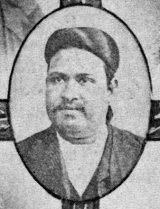G. N. Chakravarti: Difference between revisions
No edit summary |
No edit summary |
||
| Line 45: | Line 45: | ||
<references/> | <references/> | ||
[[Category:Associates of HPB|Chakravarti, G.]] | |||
[[Category:Educators|Chakravarti, G.]] | [[Category:Educators|Chakravarti, G.]] | ||
[[Category:Nationality Indian|Chakravarti, G.]] | [[Category:Nationality Indian|Chakravarti, G.]] | ||
Revision as of 21:39, 11 May 2020
Gyanandra Nath Chakravarti (1861-1936) was an Indian Theosophist and scholar who greatly impressed the world with his excellent lectures at the 1893 World's Parliament of Religions in Chicago.
Personal life and career
Chakravarti earned M.A. and LLB. degrees.
In 1902 he was an Inspector of Schools.[1]
"Throughout his life, the Vice-Chancellor, wherever he was staying, rose at three in the morning and meditated until six."[2]
Professor Chakravarti, "then pro-vice-chancellor of Banares Hindu University (BHU), was made the first vice-chancellor of the University of Lucknow on December 16, 1920.[3]
Mrs. Chakravarti
His wife, a Bengali named Monica Devi Chakravarti (1882-1944), was a remarkable woman. She had four children and was said to have adopted 40 more.
In 1925, she had an overwhelming experience of the unitive vision. She sought her husband's permission to become a wandering mendicant monk. As his wife's guru, Dr. Chakravarti invested Monica with the robes of the Vaishnava order of Vairagis. She shaved her head and took the name Sri Yashoda Mai.[4]
She became spiritual advisor to Ronald Nixon (1898–1965), who was later known as Sri Krishna Prem. They founded Mirtola, the famous ashram.[5]
1893 Parliament
in 1893, the Theosophical Society sent a delegation of speakers to the 1893 World's Parliament of Religions in Chicago, led by vice president William Quan Judge. Official delegates included Annie Besant, Professor G. N. Chakravarti, the Anagarika Dharmapala, Miss F. Henrietta Müller, and Mrs. Isabel Cooper-Oakley.
Prof. G. N. Chakravarti represented Brahmanism, bringing credentials from three Brahmanical Sabhâs. He was Professor ot Mathematics at the University of Allâhâbâd (ancient Prayâga), and a member of the T.S. Branch in that city.[6]
The Professor traveled by train from New York with Mr. Judge and Mrs. Besant. On September 9, they made a stop in Ohio and lectured at the dedication of the new Theosophical Hall of the Cincinnati Theosophical Society. Their lectures were outlined in the lodge's minutes book, which they all signed.[7]
Chakravarti and Annie Besant
It has been suggested that around the time of the Parliament, Chakravarti influenced a susceptible Annie Besant – that he cast a "glamour" over her in a manner close to black magic. Sven Eek and Boris de Zirkoff summarized this viewpoint:
It so happened that Annie Besant was especially strongly impressed by the personality of Chakravarti, and from that time on her opinions became colored by his point of view. Playing on her desire for occult powers, Chakravarti "captured" Mrs. Besant in less than two months. Judge watched his growing ascendancy over her mind with anxiety, as he intuitively felt that a subtle attempt was being made then to divert her efforts from the genuine line of occultism into a sectarian offshoot. He became more uneasy when, on Mrs. Besant's return to England with the party that included Chakravarti, she prepared to go to India on a long lecture tour, and he warned her that it was not an auspicious tie to go. Before leaving, she spent some time in London during which she saw a good deal of the Brahmana; the latter leter for India shortly before Mrs. Besant and Countess Wachtmeister started for the Orient.[8]
= Honors
A Dr. Chakravarti Gold Medal is awarded annually at Lucknow University.
Notes
- ↑ Report of the Indian Universities Commission: 1902. Page 90.
- ↑ Seymour B. Ginsberg, Masters Speak: An American Businessman Encounters Ashish and Gurdjieff (Wheaton, Illinois: Theosophical Publishing House, 2014), 17.
- ↑ Mohita Tewari, "How a Two-Room Memorial School Turned into a 225-acre Lucknow University." The Times of India. Nov 11, 2019. Available at [The Times of India website.
- ↑ Seymour B. Ginsberg, Masters Speak: An American Businessman Encounters Ashish and Gurdjieff (Wheaton, Illinois: Theosophical Publishingn House, 2014), 17-18.
- ↑ Seymour B. Ginsberg, "Mirtola: a Himalayan Ashram with Theosophical Roots" Quest 100. 3 (Summer 2012): 98-105.
- ↑ Sven Eek and Boris de Zirkoff, compilers and editors, "William Quan Judge: His Life and Work" Echoes of the Orient: The Writings of William Quan Judge (Pasadena, California: Theosophical University Press, 2011), xlv.
- ↑ Minute Book of the Cincinnati Theosophical Society. September 5-19, 1893. Cincinnati Theosophical Society Records. Records Series 20.02.01. Theosophical Society in America Archives.
- ↑ Sven Eek and Boris de Zirkoff, xlv.
